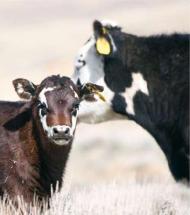The consequences of the new US Farm Bill

The new $290 billion piece of legislation meant to subsidise American farms has been said to undermine World Trade Organisation negotiations at a time of high pressure in international feed markets. Feed Tech talks with a cross-section of experts about the consequences of the 2008 Farm Bill.
By Nicholas Zeman
The opening of several million acres of Conservation Reserve Program (CRP) land for livestock foraging purposes, is a provision of the recently passed 2008 US Farm Bill, meant to relieve the country’s domestic producers from record feedstuff prices. “We think that will put $1 billion worth of feed and forage on the marketplace. Hopefully that displaces corn as a feed, at least to some extent,” said Ed Schafer, United States Secretary of Agriculture, during a June 5th press conference.
John Lawrence, director of the Iowa Beef Centre in Ames, Iowa says that in his state where there is a high concentration of ethanol plants, this low quality forage from CRP land will be mixed with distillers grains for a cheap but valuable cattle and dairy feed. This new supply, harvested from millions of acres of former CRP land will provide considerable benefits for cow-calf and stocker operations, but will not take large amounts of pressure off feed markets for the poultry, hog and dairy sectors, which require higher quality roughage, according to Mike Boehlje, professor of agricultural economics at Purdue University in West Lafayette, Ind. In addition, many CRP contracts, which provide incentives for farmers to take land out of production, are set to expire. “Most likely we will not see those contracts renewed because market prices are so high,” Boehlje says.
While pulling acres out of reserves to take pressure off feed markets does not involve funds flowing directly out of the treasury to producers, it is nevertheless a manoeuvre designed to increase the strength of US producers in the global market. Bob Friesen, president of the Canadian Federation of Agriculture says the phenomenon known as cross-subsidisation occurs when livestock producers are able to procure feed because of government assistance, to gain an advantage in the international marketplace. “The U.S. is out to buy markets,” Friesen says. “Anytime they want to grow their industries they just pump billions of dollars, or acres, into them.”
International relations
US agricultural policy has been accused of this for decades. Several of these farm programs have historically subsidised certain crops so that they can be exported cheaply enough to monopolise grain markets abroad. “This has made Canadian farmers avoid producing surplus crops highly subsidised in the US,” Friesen says.
Chad Hart, an analyst at the Centre for Agricultural and Rural Development at Iowa State University says this situation is changing. “I tend to disagree that farmers here are responding more to government policy than they are to market dynamics in how they utilise their acres,” he says. “It is true that prior to 1996, farmers had to pick crops that maintained the program base if they wanted to receive payments or specialised interest rates, but since then we have seen a loosening of government control of acreage.”
On the other hand, it’s possible to influence international trade through means besides subsidies and tariffs. Friesen tells Feed Tech that certain items in the new Farm Bill act contrary to America’s previous commitments stipulated in the North American Free Trade Agreement (NAFTA). “We basically have a free trade agreement with the United States,” Friesen says. “But they’ve started setting up non-tariff barriers.” The US-Canadian integration of the cattle and hog industries has become more and more cemented in the decades since NAFTA. Feeder pigs and cattle from Canada often end up being slaughtered in the United States because the margins are better, Friesen says. If processors have to separate animals on the production line, however, it will be a prohibitive factor discouraging purchases of Canadian livestock.
Canada sees this as an underhanded move, especially since along with Mexico it accounts for half of the United States’ top two markets worldwide, with exports forecast to reach $30.5 billion this year – some $5 billion above 2007 – according to reports released by the University of California. “If the intentions were sincere, they could have gone to voluntary labelling,” Friesen says. “All of a sudden they’ve thrown up a wall to make it harder for Canada to export animals into the US. We believe it’s a non-tariff trade barrier meant to exploit the loyalty of the American consumer, and we most likely are going to go forward with a trade challenge.”
Missed opportunity
Officially titled the Food, Conservation and Energy Act of 2008, this legislation has caused a lot of controversy all over the world since its contents began to be debated in Congress last year. It’s put President George Bush at odds with his own Republican colleagues, and made foreign countries renew their accusations that US subsidies allow its farmers to grow and export crops below the cost of production, thus putting their own producers out of work. Daniel Sumner, director of the University of California Agricultural Issues Centre, estimated that in typical years, US corn subsidies “would have caused world price suppression by about 10 percent and foreign corn production would have been suppressed by about five percent.”
The European Union says that its own progressive decoupling of subsidies, as initiated in 2003, is enabling a move toward “freedom to farm” without grants and subsidies in exchange for production. Conversely, the World trade Organisation (WTO) and others say there has been little or no reforms in America, and that the 2008 Farm Bill actually makes the situation worse. The United States Department of Agriculture and others have proposed permanent changes in subsidy programs that would make them permanently less trade distorting, and allow production to be more responsive to markets, but the legislature did not take agreement with them.
President Bush, a strong advocate of free trade, wanted to end payments to farms that made over $250,000 profit-per-year.
He said that even though crop prices have averaged a twenty percent increase since just last year, Congress still raised payment rates for most crops and created new subsidies which can be triggered even at very high prices. “The bill fails to stop the practice of collecting subsidies even when crops are sold later at a higher price; it restricts our ability to redirect food aid dollars for emergency use in the midst of a global food crisis; and it falls short of the Administration’s conservation proposals,” said President Bush in an official statement. “By increasing trade-distorting subsidies, the bill undermines our ability to open foreign markets to American agricultural goods.” Other experts interviewed by Feed Tech say, however, that feed prices are so high in the United States right now that the subsidies in the 2008 Farm Bill are unlikely to kick in for 18 months to two years, if at all. That means that the market is influencing farmers’ decisions on how to utilise their acreage more than government policy. “I think farms are paying more attention to the Chicago Board of Trade prices and making their decisions based on those numbers— much more than of government policy,” Hart says.
Some fear
But it’s good times in the farm sector which provide the perfect opportunity to change government policies. Boehlje says that it is much harder to institute reforms when commodity prices are low.
“So with prices currently well above the trigger levels for subsidies to kick in, the WTO and the European Union thought this was a good window of opportunity for the United States to introduce some reforms,” he says. “I think there’s some fear that this window might be closing and that opportunity will be lost.”
Nicholas Zeman is a US correspondent for Feed Tech. He can be reached at nicholas.zeman@und.nodak.edu
Source: Feed Tech magazine Volume 12 No.6











